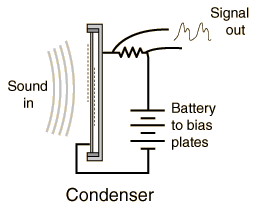Microphones
Microphones are transducers which detect sound signals and produce anelectrical image of the sound, i.e., they produce a voltage or a current which is proportional to the sound signal. The most common microphones for musical use are dynamic, ribbon, or condenser microphones. Besides the variety of basic mechanisms, microphones can be designed with different directional patterns and different impedances.

Sound reproduction concepts
| HyperPhysics***** Sound | R Nave |



